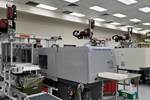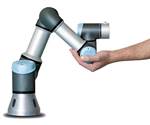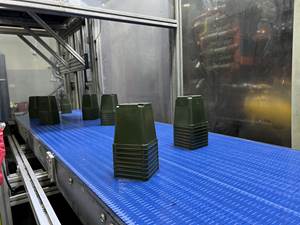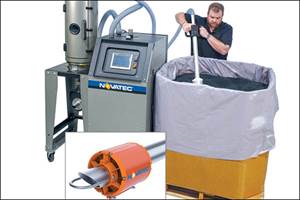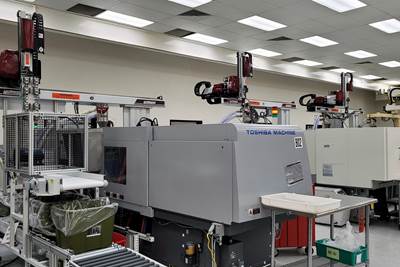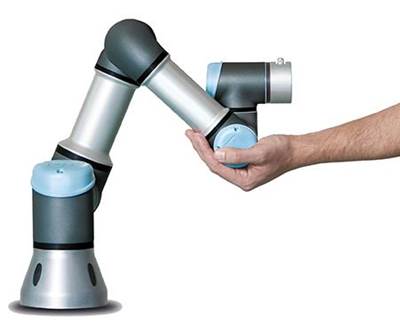AMRs and Cobots Target Inspection, Palletizing and Movement of Finished Goods
The same year it marked its 70th year in business, custom injection molder Hoffer Plastics (South Elgin, Illinois) — which routinely reinvests more than 10% of its annual revenue back into new equipment — prioritized automation in that CapEx with some stunning results.
“When you look at our investment — our belief in reinvesting in the business — it’s ultimately about making people’s jobs easier,” says Adam VanMeter, Hoffer Plastics automation project manager. “If you look at the way we’re leveraging automation, it’s really helping from a safety standpoint in ergonomics; we’re getting quality improvements; and we’re getting delivery improvements.”
The company is also getting a productivity gain in its most cherished resource. “It’s no surprise labor is tough to come by right now,” VanMeter says, “and the labor we have, we’d rather upskill them and use their mindsets and their brains for more productive tasks than moving product around the facility.”
Founded in 1953, Hoffer has grown into nine focused factories, covering 365,000 square feet, with more than 350 employees and 114 injection molding machines, running 24/7. The sprawling layout is not conducive to using fixed automation like conveyors for moving product around. The company has long deployed more traditional Cartesian robots to remove parts, runners and sprues from presses, but now it’s finding uses for less traditional modes of automation, recently investing in autonomous mobile robots (AMRs) and collaborative robots (cobots), which together handle everything from inspecting parts to filling, palletizing and transporting boxes.

Hoffer Plastics deploys custom designed autonomous mobile robots (AMR) to ferry finished goods around its facility. Source: Hoffer Plastics
“We’re using automation such as autonomous mobile robots to move that product around and have our employees focus on more value-added activities as opposed to assembling boxes or putting them on pallets,” VanMeter says.
Hoffer’s production includes several lines of proprietary products, and it targeted its Trust-T-Lok manufacturing line with multiple automation investments that have saved it more than 55,000 hours of manual labor. These include application of a cobot to provide inspection. This job was chosen based in part on its prolific production — 5,500 run hours annually across six injection molding machines. Previously, all that output would have been measured and inspected by hand. In the new automated scheme, the inspection is completed over the course of about four hours daily. Under the new process, Hoffer employees undertake a quick visual inspection; place parts into a tray that tracks cavity location; load the tray into a customized machine; start the program; and “walk away,” VanMeter says. “They don’t have to go through each part and measure the four or five different dimensions on each part because the robot takes care of all of that.”

The end effectors on this cobot serve double duty as grippers and calipers, measuring key dimensions of parts as it moves them. Source: Hoffer Plastics
Here, the cobot’s end effector acts as a caliper as well, gripping the part and simultaneously measuring it. Placing parts in different orientations, the cobot takes the measurements with that data exported to a CSV file. Because the product requires 100% inspection, these automated cells not only save Hoffer a tremendous amount of time and worker hours but also provide additional benefits. “In addition, the technology is becoming so much more advanced,” VanMeter says. “These cameras are able to process the information so much faster without impacting our cycle times. That’s where we’ve already achieved quite a bit of savings and continue to see a lot of opportunities going forward. The use of vision systems in-line in our assembly process is something that we continue to stress and implement wherever there’s a practical return on investment.”
Production On the Move
As Hoffer sought out other operations where its workers were using more brute power than brain power, its attention settled on boxes — empty boxes that need be filled and filled boxes that needed to be moved and palletized. In addition to deploying another cobot for palletizing of filled boxes, it added AMRs to simultaneously ferry filled and unfilled boxes to and from production and shipping.
The customized AMR consists of two layers, with the bottom layer storing full boxes for transport, while the top layer carries empty boxes. When in use, the AMR goes to the production cell to drop off the empty boxes in the front of the cell and then heads to the back of the cell to pick up the full boxes and deliver them to the palletizing cells.
The automation saves Hoffer’s employees from lifting between 1.5 and 2.0 million pounds.
Before the AMRs ever traveled through Hoffer, VanMeter and his team had to go through the facility with them and map out the floor. Once the AMR has the proverbial lay of the land, there’s some initial instruction, but then there’s basically full autonomy. “You have to program it step by step on what you want it to do,” VanMeter says, “but you don’t actually have to tell it where to go. You just tell it what you want it to do, and through the map and through what you programmed, it will find the most advanced, most effective route to get there.”
The programming itself is also straightforward, according to VanMeter. “The programming is not crunching numbers at a keyboard,” VanMeter says, “no scripting for the basic stuff. It’s just selecting actions in the manual and telling it what you want it to do.”
Individually, the production and boxes themselves are relatively light, but the aforementioned scale of the output raises the collective output to a different level. “We talk about an employee lifting a box or putting it on a pallet, and it doesn’t seem like that much,” VanMeter says. Over the course of a year, however, Hoffer calculated that the automation was going to save its employees from lifting between 1.5 and 2.0 million pounds. “I mean, it’s astronomical,” VanMeter says. “It really, really adds up.”
More to Come
Going forward, Hoffer has a Phase 2 for the project planned where it will automate the pickup and movement of finished kits for another job to set locations within the warehouse. In addition, it’s also planning another automated QC vision inspection, with plans into 2025 to automate a different plant. That includes working with its customer to standardize on a box used to package production. “Standardizing with our customers on the box size will let us take full advantage of the automation,” Jeff Klabunde, Hoffer’s vice president of operations, says. “It’s a win for them, a win for us and it’s just going to make us that much more efficient.”
“The labor we have, we’d rather upskill them and use their mindsets and their brains for more productive tasks than moving product around the facility.”
Working alongside a new cobot inspecting parts or palletizing boxes, or passing a fully loaded AMR in a shopfloor aisle, VanMeter says Hoffer’s employees are becoming more familiar, and welcoming, to their newest colleagues. “The vast majority of our employees have welcomed the automation with open arms,” VanMeter says. He’s been particularly impressed with the off shifts and their willingness to learn.
Klablunde says VanMeter’s efforts to train multiple employees on each shift on how to perform important functions like resetting the robots has helped with buy-in and eliminated another time-consuming task from the employees’ tasks. Formerly the third-shift production supervisor for one of Hoffer’s plants, VanMeter appreciates the steady efficiency the new automation brings.
“The automation has really allowed us to remove some elements of what I would refer to as ‘firefighting’ that we previously did,” VanMeter says, “and now that if our team members aren’t firefighting, that gives them the time to do more continuous improvement, and it feeds upon itself, this continuous improvement engine, generating more and more productivity and efficiency gains.”

Production is captured at the press by Hoffer Plastics’ custom automation system. Source: Hoffer Plastics
Related Content
Processor Turns to AI to Help Keep Machines Humming
At captive processor McConkey, a new generation of artificial intelligence models, highlighted by ChatGPT, is helping it wade through the shortage of skilled labor and keep its production lines churning out good parts.
Read MoreNew Technology Enables ‘Smart Drying’ Based on Resin Moisture
The ‘DryerGenie’ marries drying technology and input moisture measurement with a goal to putting an end to drying based on time.
Read MoreImpacts of Auto’s Switch to Sustainability
Of all the trends you can see at NPE2024, this one is BIG. Not only is the auto industry transitioning to electrification but there are concerted efforts to modify the materials used, especially polymers, for interior applications.
Read MoreExtrusion Technology Extended to Injection, Enabling Up to 100% Regrind Usage
Twin-barrel (shot-pot) press can handle more regrind, offers other benefits to molders.
Read MoreRead Next
How COVID-19 Did (and Didn’t) Change Automation in Plastics
The global pandemic invigorated longstanding trends and new market forces to push broad-based adoption of automation and robotics from the incremental to the inexorable.
Read MoreBoston Dynamics Stretches Into Autonomous Warehouse Robotics
The robotics company’s second commercial product is designed to take on physically challenging warehouse tasks.
Read MoreROBOTS TO ‘COBOTS’: Next-Gen Automation in Plastics Processing
So-called ‘collaborative robots’ are a new category of ‘human-friendly’ automation that can work safely side by side with people, unprotected by guarding.
Read More

